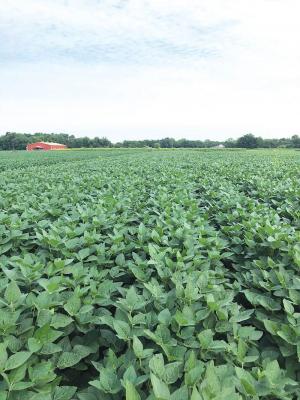2021 - Volume #45, Issue #5, Page #02
[ Sample Stories From This Issue | List of All Stories In This Issue | Print this story
| Read this issue]
Big Farmer Raises Old Variety Beans
 |
“When I was young, I asked my dad why we planted bin-run soybeans every year,” recalls Clark. “He said he felt that the soybeans had adapted to the farm’s soils and weather and kept getting better every year.”
When he took over the farm, Clark went down the road of commercial soybean seed. His thinking began to change when he first adopted no-till, then cover crops, and finally planting into green, growing cover crops. As he added more diversity to his cropping program (he now grows 7 crops), he went down the regenerative ag road and found he was using fewer inputs. His fuel, fertilizer and crop protection product costs fell dramatically. Eventually, he eliminated most off-farm inputs, aside from manure received from a local dairy farm. Doing so allowed him to gain premiums by certifying his acres as organic.
“In 2020, we saved $2 million dollars in off-farm inputs,” says Clark. “We can make money with 150-bushel corn and 40-bushel soybeans.”
Developing a line of soybeans adapted to his farm was his next step in input independence. “Geneticists today breed for yield with maximum commercial inputs,” says Clark. “Our system is built around soil, plant and human health. We feel older varieties are a better fit for what we do.”
With the help of Hunt Wiley, a long-time soybean breeder, Clark defined needed traits. “We looked for varieties that had good vigor and a health package that would help them get up and go,” says Clark. “We picked 10 varieties and grew them out. We then culled them to 5 that we are growing out in carefully managed field plots this year. They were hand-planted and weeded, nothing like our normal fields.”
Clark began by looking at varieties that were off patent. One source for old seeds is the National Lab for Genetic Resource Preservation, a USDA seed bank located in Fort Collins, Colo. Others include state departments of agriculture.
“We started with coffee cans of seed and multiplied them with each planting,” says Clark. “Next spring, we will have each of the 5 varieties ready to plant in our fields in our no-till, cover crop system.”
Clark has already identified a favorite. However, it will have to prove itself in the field. Once one of them does, the process will just be starting.
“I think it will be important for us to stay with the same genetics and raise them out. As they evolve, they will be more prolific in our system,” he says.
It is an approach he plans to adapt to off-patent corn genetics and eventually to each of the diverse crops he now raises. Clark also operates Farm Green Consulting, helping other farmers practice organic regenerative agriculture.
Contact: FARM SHOW Followup, Clark Land and Cattle Co., 563 South Hwy 41, Williamsport, Ind. 47993 (ph 765 585-7232; Rick@farmgreen.land; www.farmgreen.land).

Click here to download page story appeared in.

Click here to read entire issue
To read the rest of this story, download this issue below or click here to register with your account number.




